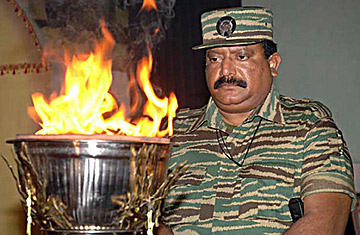
Velupillai Prabhakaran, leader of the Tamil Tigers, stands in front of an eternal flame at an undisclosed location in northern Sri Lanka
(2 of 2)
Over the following decades, Prabhakaran honed his movement into a cult of personality that glorified violence. "Armed struggle is the only way out for the emancipation of our oppressed people," he said in 1984. The LTTE steadily acquired massive caches of conventional weapons but also pioneered two of the most brutal tactics of modern guerrilla warfare: child recruitment and suicide bombing. Children as young as 10 were used to kill women and children in remote rural villages, according to a 1996 U.N. report. In combat in the 1990s, between 40% and 60% of the dead Tiger fighters in Sri Lanka were children under the age of 18, according to a 2004 Human Rights Watch report. In 1987, the LTTE established the Black Tigers — suicide cadres, many of them young women, who would be honored with a private meal in the company of Prabhakaran before being sent out on their missions. Rajiv Gandhi's assassination in 1991 was the apotheosis of this new tactic. Killed by a female suicide bomber on a campaign trip in a small town in Tamil Nadu, Gandhi had been targeted because of his decision to send in Indian peacekeeping troops to Sri Lanka in 1987 while he was Prime Minister. The Tiger leader became a wanted man in India, and the tide of public opinion in India turned decisively against the LTTE. India has a large population of ethnic Tamils, and many of them had been sympathetic to the cause of oppressed Tamils in Sri Lanka. In 2002, when pressed by journalists on his involvement in the killing, Prabhakaran refused to comment. "It is a tragic incident that happened 10 years ago," he said. "We are not in a position to make a comment." (Read about the challenge India's new government faces in Sri Lanka.)
The group's attacks continued to grow more audacious, culminating in a 2001 suicide mission at the international airport in Colombo. By the time of the 2002 cease-fire, the LTTE was essentially governing Sri Lanka's northern and eastern provinces and had the trappings of a state military complete with a rudimentary air force and navy. Prabhakaran appeared with fanfare to sign an agreement with the Sri Lankan government that year, but during four years of negotiations that followed, neither side could agree to a political compromise on autonomy for Tamil-majority areas. Confrontations between the Tigers and the government increased, and the assassinations resumed. The LTTE itself began to splinter, and one of Prabhakaran's top lieutenants, known as Karuna, broke away. With Karuna's help, the eastern provinces came under control of the government in 2007.
That left Prabhakaran with control of the north, secured by several thousand soldiers. But the transformation from running a guerrilla force to a conventional army may have been the leader's undoing. The nation's current President, Mahinda Rajapaksa, took office in 2005 and vowed to pursue a military solution. In a conventional war against an army many times its size, the LTTE was sure to be outmatched, and eventually it was. Prabhakaran never again appeared before the press after 2002, but he continued to release photos and speeches every year. "With its greed for land, Sinhalam [Sri Lanka] has entered a militaristic path of destruction," he said in his last speech in November 2008. "It has sought to build the support of the world to confront us."
Prabhakaran was correct. The LTTE had been banned by the U.S., the European Union and several other countries as a terrorist organization, and Rajapaksa pursued what he called a "war on terror" against the LTTE despite the repeated concerns of the U.N. and other groups about human-rights violations and civilian casualties inflicted by both sides. More than 220,000 Tamil civilians are still being held in the north in internment camps, and it is not clear when they will be allowed to go home. The U.N. estimates that 40,000 to 60,000 people are en route to the camps from the war zone. Another 2 million Tamils live in Colombo, under increased monitoring by the state. Nearly all of Sri Lanka's moderate Tamil politicians have been eliminated by the LTTE, which insisted that it was the only legitimate political voice for the Tamil minority. With the end of the LTTE, the Tamil National Alliance may play a greater role in negotiations for Tamil rights. There is still some hope of a political settlement that will grant Tamils some protection and greater autonomy; the Sri Lankan government is expected to ask for millions in international aid to rebuild the north. But the dream of eelam may be dead. (Read "Escape from Hell: Refugees Flee Sri Lankan War Zone.")
In its final offensive, the Sri Lankan army hunted Prabhakaran for months, even as rumors floated that he might have escaped by boat to the Persian Gulf, East Africa or Southeast Asia. By the end, he was reduced to his core group of about 250 loyalists. The body of Prabhakaran's son Charles Anthony was recovered first and displayed on television within hours of his death. Prabhakaran's life ended in Mullivaikal, a strip of land on the northeastern coast, a place not much different from where he began.
— With reporting by Amantha Perera / Colombo
